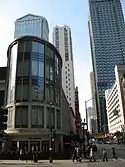Goodman Theatre
Goodman Theatre is a professional theater company located in Chicago's Loop. A major part of the Chicago theatre scene, it is the city's oldest currently active nonprofit theater organization. Part of its present theater complex occupies the landmark Harris and Selwyn Theaters property.[1]
.jpg.webp) The Goodman Theatre | |
| Location | 170 North Dearborn Street Chicago, Illinois 60601 |
|---|---|
| Coordinates | 41.8848°N 87.6299°W |
History
The Goodman was founded in 1925 as a tribute to the Chicago playwright Kenneth Sawyer Goodman, who died in the Great Influenza Pandemic in 1918. The theater was funded by Goodman's parents, Mr. and Mrs. William O. Goodman, who donated $250,000 to the Art Institute of Chicago to establish a professional repertory company and a school of drama at the School of the Art Institute of Chicago.[2] The first theater was designed by architect Howard Van Doren Shaw (in the location now occupied by the museum's Modern Wing), although its design was severely hampered by location restrictions resulting in poor acoustics and lack of space for scenery and effects.
The opening ceremony on October 20, 1925, featured three of Kenneth Sawyer Goodman's plays: Back of the Yards, The Green Scarf, and The Game of Chess. Two nights later the theater presented its first public performance, John Galsworthy's The Forest. The company mainly performed student productions with the addition of professional players through to the 1950s. In 1969 under artistic director, John Reich, it finally became a fully professional company.[3] In 1978, the drama school became part of DePaul University.
In 2000, the company moved into its new facility at 170 North Dearborn in Chicago's theater district. The 171,000 square feet (15,900 m2) project was designed by KPMB Architects, DLK Architecture Inc., and architects associated with the McClier Corporation. It has two fully modern auditoriums, named the Albert and the Owen, after two members of the Goodman family who continue to be major donors. In August 2000, associate artistic director Michael Maggio died and the company established the Michael Maggio Emerging Designer Award in his honor ; it is bestowed alongside the Michael Merritt Award for Excellence in Design and Collaboration.[4][5]
Awards
In 1992, the theatre company received the Regional Theatre Tony Award, joining Steppenwolf Theatre as Chicago-based recipients of the award. Three other Chicago-based companies, Victory Gardens Theater (in 2001), Chicago Shakespeare Theater (in 2008), and Lookingglass Theatre Company (in 2011) have also received the award, making Chicago the most recognized city in the country by this prestigious live theater award. The Goodman has also won many Joseph Jefferson awards.
Productions

With the production of Radio Golf in 2007, the Goodman became the first theater to mount a production of each of the ten plays in August Wilson's Pittsburgh cycle.
The theater has presented A Christmas Carol annually in December since the 1970s.
Other productions the Goodman has staged over the years include Hay Fever, Lady Windermere's Fan, The Little Foxes, You Can't Take it with You, Born Yesterday, Pal Joey, To Be Young, Gifted and Black (play), Guys and Dolls, Talley's Folly, A House Not Meant to Stand, A Soldier's Play, Fences, Sunday in the Park with George, The Visit, Dancing at Lughnasa, Arcadia, Floyd Collins, Hollywood Arms, Dinner with Friends, The Goat, or Who is Sylvia?, The Light in the Piazza, I Am My Own Wife, and Rabbit Hole.[1]
Community outreach
In addition to the Goodman's many productions, the theater also hosts many different education programs. It partners with community organizations, schools, and juvenile detention programs. During the school year, the Goodman hosts the Cyndie Bandle Young Critics (CBYC) and the Goodman Youth Arts Council (GYAC). CBYC creates opportunities for young people to grow their writing skills through creating critical and analytical works. Participants have the opportunity to critique each show at the Goodman for reviews for their neighborhood and school papers. Participants of the GYAC volunteer in workshops for young children, nursing homes; and clothing and food drives. They have occasionally marched with public school teachers who were on strike.
Summer programs are focused on youth and young adults ages fourteen to twenty-four. Playbuild is a seven week workshop; a group of eighty teens throughout Chicago collaborate through several different applied theatre exercises to express themselves with artistic choices. The Goodman hosts a Musical Theatre Intensive (MTI) which runs alongside Playbuild. With a more traditional approach to theatre education, teens audition with a monologue and song, learning to be more confident and mature in performances in their art form. [6]
See also
References
- "Our History". Goodman Theatre. Retrieved August 14, 2020.
- "Goodman Memorial Theatre". Bulletin of the Art Institute of Chicago. 38 (6): 101. November 1944. JSTOR 4112503.
- Jones, Chris (2013). Bigger, brighter, louder: 150 years of Chicago theater as seen by Chicago Tribune critics. University of Chicago Press. p. 189. ISBN 978-0226059266.
- Jones, Kenneth (August 21, 2000). "Esteemed Chicago Director Michael Maggio Dead at 49". Playbill. Retrieved August 14, 2020.
- "Michael Merritt Design Awards". Facebook.
- Taylor, Willa J. (2021-06-01), "Goodman Theatre", Applied Theatre with Youth, London: Routledge, pp. 13–21, retrieved 2021-12-07
Further reading
- Appler, Gilbert Keith. "Chicago’s Goodman Theatre: Plays and Cultural Work in an Institutional Theatre." PhD dissertation, University of Illinois-Urbana. 1994
- Medgyesy, Laura Louise. "Chicago's Goodman Theatre: the transition from a division of the Art Institute to an independent regional theatre." PhD dissertation, American University. 1981
- Teague, Anna Dean. "Thomas Wood Stevens' Contributions to American Art Theatre With Emphasis on the Kenneth Sawyer Goodman Memorial Theatre, 1922-1930," PhD dissertation, The Louisiana State University, 1973.
External links
- Official website
- Goodman Theatre at the Internet Broadway Database
- Kenneth Sawyer Goodman Papers and Goodman Family Papers at The Newberry Library